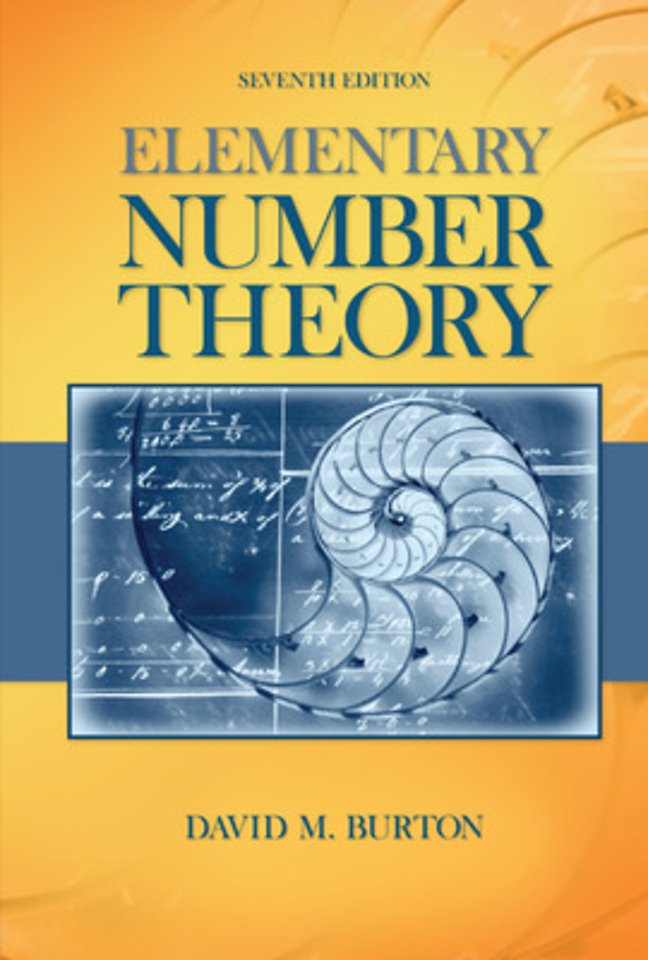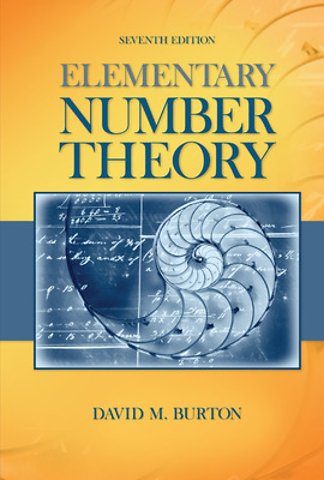<h1> Elementary Number Theory, 7e, by David M. Burton </h1><h1> Table of Contents </h1><h2> Preface </h2><h2> New to this Edition </h2><h2> 1Preliminaries </h2><h4> 1.1Mathematical Induction </h4><h4> 1.2The Binomial Theorem </h4><h2> 2Divisibility Theory in the Integers </h2><h4> 2.1Early Number Theory </h4><h4> 2.2The Division Algorithm </h4><h4> 2.3The Greatest Common Divisor </h4><h4> 2.4The Euclidean Algorithm </h4><h4> 2.5The Diophantine Equation </h4> <h2> 3Primes and Their Distribution </h2><h4> 3.1The Fundamental Theorem of Arithmetic </h4><h4> 3.2The Sieve of Eratosthenes </h4><h4> 3.3The Goldbach Conjecture </h4><h2> 4The Theory of Congruences </h2><h4> 4.1Carl Friedrich Gauss </h4><h4> 4.2Basic Properties of Congruence </h4><h4> 4.3Binary and Decimal Representations of Integers </h4><h4> 4.4Linear Congruences and the Chinese Remainder Theorem </h4><h2> 5Fermat’s Theorem </h2><h4> 5.1Pierre de Fermat </h4><h4> 5.2Fermat’s Little Theorem and Pseudoprimes </h4><h4> 5.3Wilson’s Theorem </h4><h4> 5.4The Fermat-Kraitchik Factorization Method </h4><h2> 6Number-Theoretic Functions </h2><h4> 6.1The Sum and Number of Divisors </h4><h4> 6.2 The Möbius Inversion Formula </h4><h4> 6.3The Greatest Integer Function </h4><h4> 6.4An Application to the Calendar </h4><h2> 7Euler’s Generalization of Fermat’s Theorem </h2><h4> 7.1Leonhard Euler </h4><h4> 7.2Euler’s Phi-Function </h4><h4> 7.3Euler’s Theorem </h4><h4> 7.4Some Properties of the Phi-Function </h4><h2> 8Primitive Roots and Indices </h2><h4> 8.1The Order of an Integer Modulo n </h4><h4> 8.2Primitive Roots for Primes </h4><h4> 8.3Composite Numbers Having Primitive Roots </h4><h4> 8.4The Theory of Indices </h4><h2> 9The Quadratic Reciprocity Law </h2><h4> 9.1Euler’s Criterion </h4><h4> 9.2The Legendre Symbol and Its Properties </h4><h4> 9.3Quadratic Reciprocity </h4><h4> 9.4Quadratic Congruences with Composite Moduli </h4><h2> 10Introduction to Cryptography </h2><h4> 10.1From Caesar Cipher to Public Key Cryptography </h4><h4> 10.2The Knapsack Cryptosystem </h4><h4> 10.3An Application of Primitive Roots to Cryptography </h4><h2> 11Numbers of Special Form </h2><h4> 11.1Marin Mersenne </h4><h4> 11.2Perfect Numbers </h4><h4> 11.3Mersenne Primes and Amicable Numbers </h4><h4> 11.4Fermat Numbers </h4><h2> 12Certain Nonlinear Diophantine Equations </h2><h4> 12.1The Equation </h4><h4> 12.2Fermat’s Last Theorem </h4><h2> 13Representation of Integers as Sums of Squares </h2><h4> 13.1Joseph Louis Lagrange </h4><h4> 13.2Sums of Two Squares </h4><h4> 13.3Sums of More Than Two Squares </h4><h2> 14Fibonacci Numbers </h2><h4> 14.1Fibonacci </h4><h4> 14.2The Fibonacci Sequence </h4><h4> 14.3Certain Identities Involving Fibonacci Numbers </h4><h2> 15Continued Fractions </h2><h4> 15.1Srinivasa Ramanujan </h4><h4> 15.2Finite Continued Fractions </h4><h4> 15.3Infinite Continued Fractions </h4><h4> 15.4Farey Fractions </h4><h4> 15.5Pell’s Equation </h4><h2> 16Some Recent Developments </h2><h4> 16.1Hardy, Dickson, and Erdös </h4><h4> 16.2Primality Testing and Factorization </h4><h4> 16.3An Application to Factoring: Remote Coin Flipping </h4><h4> 16.4The Prime Number Theorem and Zeta Function </h4><h2> Miscellaneous Problems </h2><h2> Appendixes </h2><h2> General References </h2><h2> Suggested Further Reading </h2><h2> Tables </h2><h2> Answers to Selected Problems </h2><h2> Index </h2>

